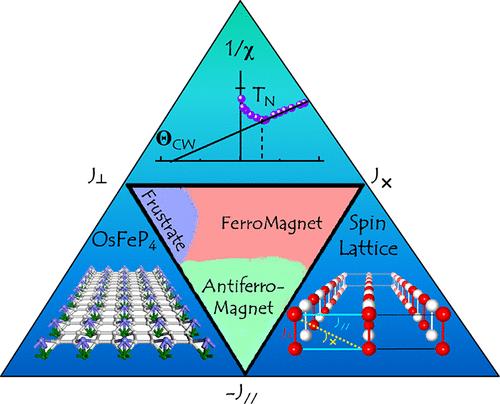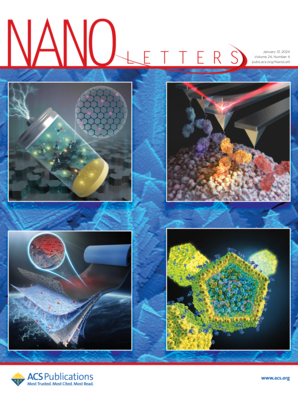具有双层四方自旋晶格的坚固二维受挫磁体的自组装设计
IF 9.6
1区 材料科学
Q1 CHEMISTRY, MULTIDISCIPLINARY
引用次数: 0
摘要
本文章由计算机程序翻译,如有差异,请以英文原文为准。

Self-Assembly Design of a Robust 2D Frustrated Magnet with Bilayer Tetragonal Spin–Lattice
We intentionally designed a stable two-dimensional (2D) bilayer dimer system, OsFeP4, which serves as a tunable spin-5/2 J1-J2 anisotropic Heisenberg-like model to investigate frustrated magnetism. The frustrated state of 2D OsFeP4 originates from the robust intradimer ferromagnetic (FM) exchange coupling (J⊥) and a subtle competition between P4 molecules mediating interdimer ferromagnetic (J∥) and antiferromagnetic (AFM) exchange coupling (J×). This is further supported by a significant broadening of the specific heat peak, a high frustration factor (θCW/TN) of 4.17, the peak at the gamma point in the static structural factor, and short-range spin textures. Moreover, we employ strain to modulate the frustration parameter J×/J∥ from 0.23 to 0.4 and spin direction from in-plane to out-of-plane. The FM, AFM, and frustrated phase transitions are identified in the J⊥–J×–J∥ ternary phase diagram. This work will enrich our understanding of the frustration mechanisms in the 2D limit.
求助全文
通过发布文献求助,成功后即可免费获取论文全文。
去求助
来源期刊

Nano Letters
工程技术-材料科学:综合
CiteScore
16.80
自引率
2.80%
发文量
1182
审稿时长
1.4 months
期刊介绍:
Nano Letters serves as a dynamic platform for promptly disseminating original results in fundamental, applied, and emerging research across all facets of nanoscience and nanotechnology. A pivotal criterion for inclusion within Nano Letters is the convergence of at least two different areas or disciplines, ensuring a rich interdisciplinary scope. The journal is dedicated to fostering exploration in diverse areas, including:
- Experimental and theoretical findings on physical, chemical, and biological phenomena at the nanoscale
- Synthesis, characterization, and processing of organic, inorganic, polymer, and hybrid nanomaterials through physical, chemical, and biological methodologies
- Modeling and simulation of synthetic, assembly, and interaction processes
- Realization of integrated nanostructures and nano-engineered devices exhibiting advanced performance
- Applications of nanoscale materials in living and environmental systems
Nano Letters is committed to advancing and showcasing groundbreaking research that intersects various domains, fostering innovation and collaboration in the ever-evolving field of nanoscience and nanotechnology.
 求助内容:
求助内容: 应助结果提醒方式:
应助结果提醒方式:


